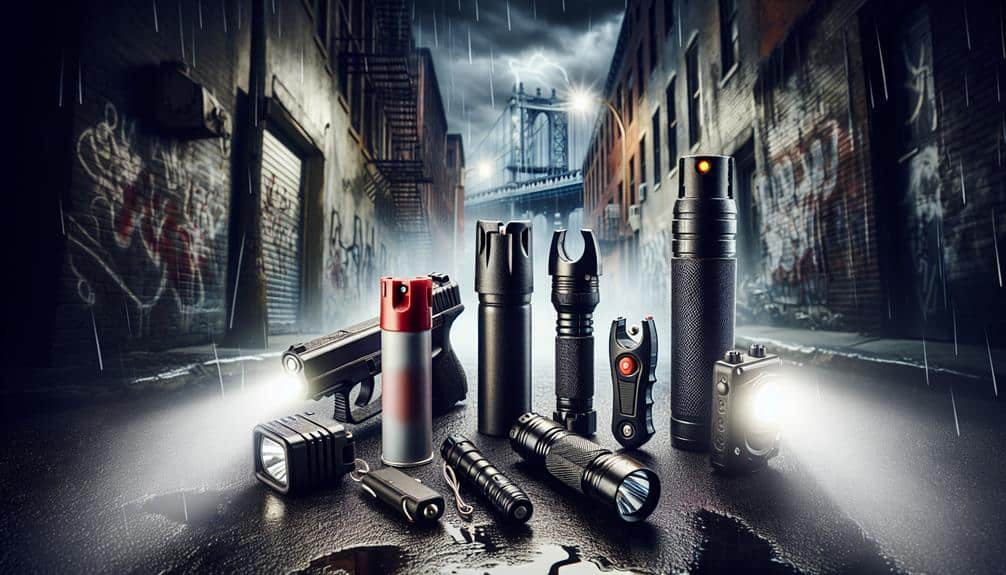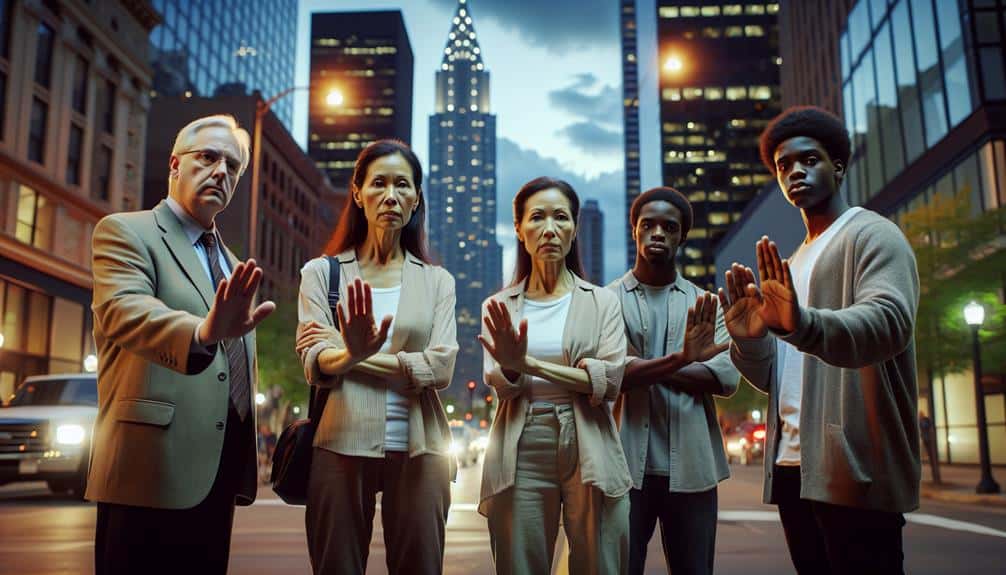Master the Art of Urban Self-Defense With This Comprehensive Guide!

Urban life can be a thrilling adventure, but it’s not without its dangers. You’ll need to master the art of urban self-defense to stay safe and confident. Imagine walking home at night, always aware, ready to spot potential threats and know the escape routes. Practice striking, blocking, and grappling till they’re second nature. Stay fit with strength and agility drills; even yoga can help! Legal know-how and the right tools are your secret weapons. Don’t forget, effective communication and de-escalation can be lifesavers. Make it a family affair, boosting everyone’s readiness. Keep exploring, and you’ll uncover all the skills you need!
Understanding Urban Threats

Urban threats encompass a myriad of dangers that you need to recognize to stay safe in densely populated areas. From crime and violence to natural disasters, cities can be unpredictable. Understanding these urban threats is essential for your safety and self-defense. You can’t just stroll through the city without a care in the world, right? That’s where a good Self Defense Manual comes in handy.
Imagine you’re walking home late at night. The streetlights flicker, and shadows loom. You need to be aware of your surroundings. Knowledge of urban survival isn’t just for action heroes—it’s for everyone. Being clued-in about common urban threats helps you prepare and protect yourself effectively.
Think of it like this: you’re not just a city dweller; you’re an urban survivalist. By recognizing potential risks, you empower yourself to make informed decisions. Maybe you avoid that sketchy alley or keep your valuables out of sight. It’s all about being proactive.
Basic Self-Defense Techniques
Mastering basic self-defense techniques like striking, blocking, and grappling is essential for staying safe in urban environments. Imagine you’re walking home late at night, and suddenly, you sense danger. Knowing how to strike effectively can make all the difference.
A well-placed punch or kick can create the opportunity for you to escape. When it comes to blocking, think of your hands and arms as shields; they can protect critical areas like your face and torso from incoming attacks.
Next, grappling might sound like something out of a wrestling match, but it’s incredibly useful in self-defense. If someone grabs you, knowing how to break free or use their momentum against them can turn the tables in your favor. Remember, these techniques aren’t about being the strongest person on the block; they’re about using what you have wisely.
Regular practice is key. The more you train, the more naturally these moves will come to you, boosting your confidence and readiness. You don’t need to be a martial arts master, but having a few reliable techniques up your sleeve can significantly enhance your self-defense in an urban environment.
Stay prepared, stay safe!
Situational Awareness Tips

Staying alert and scanning your surroundings are essential steps to boost your situational awareness in urban environments. Imagine walking down a bustling city street, where every corner holds a potential surprise. By staying vigilant, you can spot unusual behaviors or potential threats before they become problems. Think of yourself as a detective—notice the exits, identify hiding spots, and trust your instincts. If something feels off, it probably is.
Urban self-defense isn’t just about physical skills; it’s about using your brain. Pay attention to the people around you. Is someone acting strangely? Are they following you? Don’t be afraid to make eye contact—confidence can deter would-be attackers. Practicing these habits daily will make them second nature, helping you stay safe without a second thought.
Picture this: you’re in a crowded subway, and you spot someone acting suspiciously. Because you’ve honed your situational awareness, you’re already thinking about the nearest exit and potential escape routes. This proactive mindset can help you avoid confrontations and keep you and your loved ones safe.
Effective Communication Strategies
Building on your situational awareness, knowing how to communicate effectively can be a game-changer in high-stress situations. You need to master both verbal and non-verbal communication cues. Imagine you’re in a tense confrontation; your body language, tone of voice, and even your facial expressions can either escalate or defuse the situation.
Effective communication strategies involve not just what you say, but how you say it. Active listening skills are important here. By genuinely listening, you can better assess threats and respond appropriately. Remember, your goal isn’t just to talk but to understand and be understood.
| Verbal Techniques | Non-Verbal Cues |
|---|---|
| Assertiveness | Eye Contact |
| Boundary-Setting | Body Posture |
| De-escalation | Facial Expressions |
Now let’s talk about assertiveness and boundary-setting. You’ve got to practice being firm yet respectful. It’s about standing your ground without being aggressive. And hey, if humor fits the moment, a little joke can sometimes lighten the mood and ease tension.
Imagine you’re saying, ‘Hey, let’s just cool down and talk this out.’ Your calm tone and relaxed posture can work wonders. So, next time you find yourself in a sticky situation, use these strategies to keep things from boiling over.
Physical Conditioning for Defense

When it comes to urban self-defense, your physical conditioning is vital, so let’s focus on building strength and stamina, along with flexibility and agility.
Imagine trying to fend off an attacker without the endurance to keep up or the agility to maneuver quickly—it’s like bringing a butter knife to a sword fight.
You’ll need a mix of cardio, strength training, and flexibility drills to become a well-rounded defender, ready to react swiftly and powerfully in any situation.
Strength and Stamina Training
Improving your strength and stamina is essential for effective self-defense in urban settings. When you’re faced with a threat, having the muscle power and endurance to respond can make all the difference. Strength training and stamina training are your best friends here, helping you build the physical conditioning needed to handle confrontations.
To get started, here’s a simple, effective routine:
- Weightlifting: Pumping iron isn’t just for bodybuilders. Lifting weights boosts muscle strength, making your punches harder and your grapples stronger.
- Bodyweight Movements: Push-ups, squats, and lunges build functional strength that directly translates to self-defense moves. Plus, you can do them anywhere!
- Cardiovascular Activities: Running, cycling, or even brisk walking improve your stamina. You’ll need that extra endurance to outlast any physical confrontation.
- Circuit Training: Combine strength and cardio in one go. A mix of exercises like burpees, kettlebell swings, and jump rope keeps your heart rate up and muscles working.
Consistent strength and stamina training will greatly enhance your ability to defend yourself in urban environments.
Flexibility and Agility Drills
Incorporating flexibility and agility drills into your routine is essential for enhancing your self-defense skills in urban environments. Flexibility drills improve your range of motion, letting you react quickly and evade threats. Imagine dodging an unexpected punch because your body’s as limber as a cat’s! Agility drills, on the other hand, focus on quick movements and footwork, making you light on your feet and spatially aware. These drills are your secret weapons in urban self-defense, helping you stay one step ahead of danger.
Let’s break it down:
| Flexibility Drills | Agility Drills |
|---|---|
| Stretching | Ladder Drills |
| Yoga Poses | Cone Drills |
| Dynamic Warm-Ups | Shuttle Runs |
| Foam Rolling | High Knees |
Regularly practicing these drills can boost your readiness and capability to respond to sudden threats effectively. Think of it as turning yourself into a ninja, ready to slip through tight spots and sprint away from trouble. Plus, who doesn’t want to feel like a superhero, right? So, get moving, stretch those muscles, and start weaving around obstacles. Your urban self-defense game will thank you!
Legal Aspects of Self-Defense
Understanding the legal aspects of self-defense can be complex but grasping the key principles is essential for staying within the law. When you’re trying to survive in an urban environment, knowing what you can and can’t do legally can make all the difference.
First off, self-defense laws vary by location, so it’s important to know your local regulations. The last thing you want is to defend yourself and then get into legal trouble.
Here are some key points to keep in mind:
- Imminent Threat: You must perceive an immediate threat to your safety. You can’t just act preemptively.
- Proportionality: Your response should match the level of threat. Going overboard can land you in hot water.
- Duty to Retreat: In some places, you’re required to retreat if possible before using force. Check your local laws!
- Reasonable Force: Only use the amount of force necessary to neutralize the threat. Excessive force can lead to legal consequences.
Consulting a legal professional or familiarizing yourself with local laws can help you be prepared. Ignorance isn’t an excuse, so take the time to educate yourself on these legal aspects of self-defense.
Choosing Self-Defense Tools

Choosing the appropriate self-defense tools can greatly improve your personal safety in an urban environment. First, think about the effectiveness and legality of options like pepper spray, stun guns, or personal alarms. You don’t want to carry something that’s illegal in your area, so always check local laws and regulations. Imagine getting into trouble just for trying to stay safe—talk about irony!
Next, consider how easily you can use these tools. You don’t want to fumble around in a crisis. Look for something portable and reliable. Pepper spray might fit nicely in your pocket, but can you use it quickly under stress? Stun guns pack a punch, but are they legal where you live?
Training is key. You have to practice to make sure you can handle these tools effectively. It’s like learning to ride a bike—you need to build muscle memory. You wouldn’t want your first time using pepper spray to be in a real emergency, right?
Training With Family Members
Training with family members in self-defense not only boosts everyone’s skills but also strengthens your collective ability to respond to urban threats. Imagine this: you’re not just a lone wolf but part of a well-coordinated pack, ready to handle whatever the city throws at you.
Practicing self-defense together can transform your family into a tight-knit unit, enhancing Family Safety while making Urban Survival: A Family affair.
By involving everyone in self-defense training, you create a supportive environment where each person feels empowered and confident. Here are four key benefits:
- Enhanced Situational Awareness: Practicing together sharpens everyone’s ability to spot potential dangers and react quickly.
- Strengthened Bonds: Working out strategies and techniques together fosters unity and shared responsibility for each other’s safety.
- Boosted Confidence: Each family member gains essential skills, making them feel more secure and capable in urban settings.
- Prepared Household: Regular training makes sure that everyone knows their role and how to act in emergencies, creating a well-prepared home.
De-escalation Tactics

When you’re in a tense situation, staying calm and using gentle, clear words can make a huge difference.
Pair that with non-threatening body language, like keeping your hands visible and maintaining a relaxed posture, and you’ll help ease the tension.
Calm Verbal Communication
Mastering calm verbal communication can be a lifesaver when you need to manage tense situations in urban environments. Whether you’re walking home late at night or maneuvering a crowded subway, knowing how to use your words to defuse conflicts is essential for your urban survival. Here are some key strategies to help you stay calm and communicate effectively:
- Listen actively: Show the other person you’re paying attention by nodding and making eye contact. This can help them feel heard and understood, reducing their aggression.
- Speak softly and clearly: A calm, gentle tone can work wonders in de-escalating conflicts. It shows you’re not a threat and can help diffuse tension.
- Use empathy: Try to understand the other person’s perspective. Phrases like ‘I see where you’re coming from’ or ‘I understand how you feel’ can go a long way in calming someone down.
- Set boundaries politely: If someone’s getting too aggressive, assert your boundaries respectfully. Say something like, ‘I want to help, but I need you to lower your voice.’
Mastering these simple yet effective tactics can make all the difference in keeping you safe and secure in any urban setting.
Non-Threatening Body Language
Adopting non-threatening body language can be the key to de-escalating tense situations and ensuring your safety in urban environments. Imagine you’re walking down a busy street, and suddenly, a confrontation arises. What do you do?
First, maintain an open body posture – keep your arms relaxed at your sides, not crossed defensively. This signals you’re approachable and not looking for a fight.
Avoiding direct eye contact is also essential. Staring can be seen as aggressive, so instead, look slightly away, showing you’re not a threat. Speaking calmly, with a soft tone, can work wonders in diffusing tension. Your voice should be like a gentle wave, not a crashing tide.
Non-verbal cues are your allies here. Nodding and subtly mirroring the other person’s body language can create a sense of rapport, showing you’re on the same page. And don’t forget personal space! Keep a respectful distance; invading someone’s personal space can escalate things quickly.
Essentially, your body language should say, ‘I’m here to communicate, not to confront.’ So, next time you find yourself in a sticky situation, remember these tips – they might just make all the difference.
Building a Safe Routine
Imagine this: Developing a safe routine in an urban environment starts with prioritizing situational awareness and consistent self-defense training. You’ve got to be vigilant and proactive, not just reactive. Imagine this scenario: You’re walking down a bustling city street, blending in, eyes scanning your surroundings. You’re not just another face in the crowd; you’re aware, prepared, and ready to act if needed.
Here are four steps to help you build a solid routine:
- Stay Aware: Always be mindful of your surroundings. Notice exits, potential threats, and safe spots like well-lit areas or populated places. Think of it as your urban radar.
- Blend In: Dress and act in a way that doesn’t draw unwanted attention. You’re a ninja in plain clothes, moving seamlessly through the city.
- Learn Self-Defense: Regularly train in self-defense techniques. It’s not just about fighting; it’s about knowing when and how to protect yourself and your loved ones.
- Family Safety Measures: Teach your family essential safety protocols and self-defense moves. Make it a fun, engaging activity so everyone’s on the same page.
Frequently Asked Questions
How Can I Maintain Self-Defense Skills While Traveling?
You can maintain self-defense skills while traveling by using portable equipment for travel workouts. Stay vigilant and practice situational awareness in new environments. Regularly train with tools like resistance bands or jump ropes to stay sharp.
What Are Some Common Mistakes to Avoid in Self-Defense Situations?
In self-defense situations, don’t let panic reactions take over. Avoid misjudged distance that leaves you vulnerable. Using excessive force can escalate the situation unnecessarily. Stay calm, assess your surroundings, and act with controlled precision.
How Can Self-Defense Training Improve My Overall Confidence?
Self-defense training boosts your overall confidence by enhancing mental resilience, improving body posture, and teaching assertive communication. You’ll feel more secure and capable in various situations, knowing you can protect yourself if needed.
Are There Self-Defense Techniques Suitable for Children and Elderly?
Yes, there are self-defense techniques suitable for children and the elderly. Child safety and elderly awareness are essential, and age-appropriate techniques focus on simple, effective moves that anyone can use to protect themselves.
How Do I Find a Reputable Self-Defense Instructor or School?
To find a reputable self-defense instructor or school, check their instructor credentials, inquire about class size for personalized attention, and ask if they offer trial classes. This guarantees you’re comfortable and confident in your choice.

